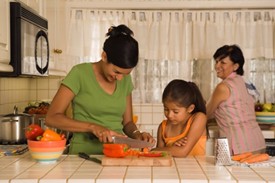13 : Engaging Families
Teachers can use the following strategies to help families to develop their children’s mathematical understanding:
Communicate to families
the broader aspects of developing number sense; for example, using counting in real-life situations, comparing numbers and discussing which is more or less, making estimations (e.g., How many grapes are in this bowl?), and solving simple addition and subtraction problems.
what classification and patterning are about and how they contribute to children’s understanding of mathematics. the importance of early measuring experiences and types of measurement experiences they can do with children. that mathematical reasoning is being able to think mathematically and explore different ways of solving problems
Remind parents that daily use of numbers (which are everywhere!) can become learning experiences for children. Provide number-related games and books that children can take home or that families can make or purchase.
Encourage parents to
involve children in everyday measurement experiences
refer to shapes in the environment when talking with children use spatial words in everyday interactions with children
recognize math in everyday events and interactions and turn them into learning experiences[1]


References
Figure 7.14: Cooking and baking are excellent opportunities to explore math with children.[2]
- The California Preschool Curriculum Framework, Volume 1 by the California Department of Education is used with permission
- Image by FNS Midwest is in the public domain.
: Engaging Families by Jennifer Paris, Kristin Beeve, & Clint Springer has no license indicated.
Young children have a natural interest, curiosity, and competence to explore and construct mathematical concepts. Mathematics is a way of thinking and organizing the world around us. It is a natural part of day-to-day activities and events. Mathematics in preschool is learned through children’s play and exploration as in the blocks area or the sandbox, through everyday routines such as setting the table and cleaning up, and through participation in teacher-initiated activities. Some teacher-initiated activities are designed with a focus on math, and others may focus on art, movement, literacy, or science but present opportunities for math learning.
When teachers recognize the potential for exposure to math in different situations, they can turn everyday occurrences into exciting and effective mathematics-learning experiences. Children are excited to explore the size or volume of objects, to discover and create patterns, to manipulate and build with shapes, to sort and classify objects, and to try to figure out “how many.” Teachers get to experience with children the day-to-day excitement of learning and discovering math. This process is joyful for the children and for the teacher, who guides and challenges them in building mathematical concepts, skills, and language [1]
Pause to ReflectMany adults (including parents and teachers) shy away from math because they “aren’t good at it.” How do you feel about math? How comfortable are you “teaching” math? Has the way this chapter presented math affected that at all? If so, how?
References
[1] The California Preschool Curriculum Framework, Volume 1 by the California Department of Education is used with permission
: Conclusion by Jennifer Paris, Kristin Beeve, & Clint Springer has no license indicated.
